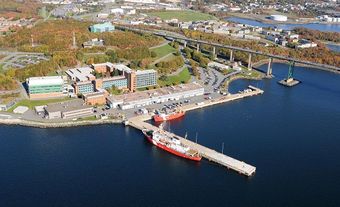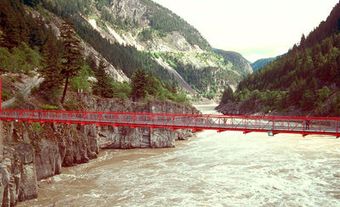
Wildlife Preserve
A wildlife preserve is an area of land or water set aside from at least some forms of development or recreational use, particularly from industrial use, hunting and motorized recreation, to protect wildlife and their habitats. Wildlife preserves are found, under extremely varied conditions, in virtually every part of the world. In Canada, they are established by federal, provincial and local governments, as well as by private organizations and individuals. Their aims vary but usually include at least some aspects of the following: to protect endangered, threatened, vulnerable or rare species; or to provide a sanctuary for species that are important for hunting or tourism. Wildlife preserves may also protect wildlife that is important to Aboriginal people for subsistence and cultural activities. The educational and wildlife viewing facilities provided by wildlife preserves have contributed to the growing awareness of CONSERVATION and the growth of BIRD WATCHING and nature photography. For example, the Wildlife Interpretation Centre of the Creston Valley Wildlife Management Area, BC, combines excellent educational facilities with the opportunity to explore part of the internationally recognized wetland. Some preserves, such as game and wildlife sanctuaries or ecological reserves, are established specifically to protect wildlife; many others, such as national and provincial parks, also have other goals such as landscape protection and recreation.
Wildlife Preserves in Canada
Canadian conservation had its start in the later 1800s, when the extinction or near-extinction of the PASSENGER PIGEON, Labrador duck, GREAT AUK, wild turkey (seeGAME BIRD), elk (seeWAPITI) and bison in the East, and the drastic reduction of large mammals in the West (BISON, pronghorn, elk) and the North (muskox), caused Canadians to press for wildlife preserves. The first preserves were NATIONAL PARKS in the West, where land was as yet unsettled. These were originally established primarily for tourism. To save the bison, WOOD BUFFALO NATIONAL PARK was established in 1922 on the Alberta/Northwest Territories border, and bison from Montana were settled there. In the early 20th century many large game sanctuaries were established in the Arctic to protect the wildlife that northern Aboriginal people depended on for food and clothing; these were largely abolished in the 20 years following World War II.
In Saskatchewan and Alberta, 3 national sanctuaries were established (1914-15) to counteract habitat alteration caused by farming, which was endangering the PRONGHORN. These were so successful that they were abolished by 1947 because the pronghorn no longer needed protection. MUSKOXEN were saved, first through game laws, then by the establishment of the Thelon Game (now Wildlife) Sanctuary, NWT and Nunavut, in 1927. In 1986 Canada's first national wildlife area (NWA) was established at Polar Bear Pass, BATHURST ISLAND, formerly an International Biological Programme (IBP) site. Now there are more than 50 NWAs protecting nearly 1 000 000 ha of wildlife habitat. Environment Canada also manages more than 90 migratory BIRD SANCTUARIES across Canada.
Increasingly, there is international cooperation on migratory and other bird species conservation. For example, the Western Hemisphere Shorebird Reserve Network (WHSRN) includes sites in Alberta, Saskatchewan and the Bay of FUNDY in Atlantic Canada. The Important Bird Areas Program (IBA), started by Birdlife International, and managed in Canada by NATURE CANADA and Bird Studies Canada, has designated some 600 sites since 1996 and works to develop management plans and protection for them.
A form of wildlife preserve, and one for which Canada, with its many lakes and extensive coastline, has great potential, is the aquatic preserve, intended to protect aquatic wildlife and habitats. Such preserves, even more than terrestrial ones, are prone to recreational overuse. Motorboating, scuba diving and even swimming cause considerable disturbance in aquatic ecosystems, including the habitats of nesting waterfowl. FATHOM FIVE NATIONAL MARINE PARK, Ont, Canada's first NATIONAL MARINE CONSERVATION AREA (established in 1987), is a good freshwater example of an aquatic preserve. There are 2 other national marine conservation areas, SAGUENAY-ST LAWRENCE MARINE PARK, Que and Lake Superior National Marine Conservation Area, Ont. Robson Bight (Michael Bigg) Ecological Reserve, off the northeastern shore of Vancouver Island, is an important area for KILLER WHALES, established in 1982. Witless Bay Ecological Reserve in Newfoundland and Labrador supports SEABIRDS and marine conservation, as well as whale watching and sea kayaking activities.
At more local levels, some municipal governments have environmental designations such as "environmentally significant area" (ESA). They also have established nature sanctuaries, which have high value for wildlife, and provide nature education and low impact recreational opportunities such as walking and nature observation, eg, Swan Lake Christmas Hill Nature Sanctuary in the district of Saanich near Victoria and Burns Bog Nature Reserve in Delta, BC.
There are also numerous private reserves of different kinds, established by organizations and individuals to protect wildlife habitat -- most often for migratory waterfowl and other game animals. Although most such preserves have been developed since the mid-1960s, the Jack MINER Bird Sanctuary in Kingsville, Ont, was established in 1904, and Long Point Company in 1866 (some of its land was donated in 1978 for the LONG POINT NWA). Private, non-profit organizations like DUCKS UNLIMITED CANADA, a private waterfowl conservation organization, or the Nature Conservancy, a habitat protection group, have secured and developed wildlife habitat across Canada through outright ownership of land and, more often, through easements and stewardship agreements with Canadian landowners who provide land free of charge.
Wildlife preserves protect many different plants and animals. For example, Long Point Provincial Park, Ont, is visited by many kinds of waterfowl and is home to at least 5 rare or endangered species of reptiles and amphibians. The Kitasoo Spirit Bear Conservancy on British Columbia's West Coast protects the rainforest habitat of the Kermode or spirit bear (a white phase of BLACK BEAR) as well as of other black bears and grizzlies. The calving grounds of 2 caribou herds are within the boundaries of TUKTUT NOGAIT NATIONAL PARK (NWT) and IVVAVIK NATIONAL PARK (Yukon).
POINT PELEE NATIONAL PARK, Ont, is a world-renowned stopping point for songbirds during migration. Birds of prey, rare in much of North America, are relatively common in western and northern Canadian preserves. Two preserves in British Columbia's HAIDA GWAII are refuges for the peregrine falcon; others, in the East, protect marine birds such as cormorants, kittiwakes, gannets and razorbills.
Challenges
Except for the relatively few, and usually small, strict preserves, such as ecological reserves, wildlife preserves in Canada often have limited restrictions on activities except hunting. Thus, wildlife preserves are often in jeopardy from human activities. If an area is popular for recreation, camping and hiking may degrade vegetation or disturb wildlife; motorized recreation even more so. There may be pressures to permit logging, or use the area for rangeland, oil exploration and drilling, or mining. Roads or rails through a preserve result in animals being killed by vehicles. POLLUTION either from spraying timber with insecticides or from sources such as ACID RAIN from distant industries can affect both plants and animals. Wildlife often wanders outside of preserves, where it may be vulnerable to (or help support) hunting and trapping (for example, wolves in ALGONQUIN PROVINCIAL PARK, Ont). Other wildlife species, such as caribou or many North American songbirds, migrate from areas or countries where they are protected to ones where they are not.
Canada's Aboriginal peoples have taken an increasingly strong role in supporting wildlife management and protection, to support their traditional subsistence practices and cultures, and their comprehensive LAND CLAIMS frequently lead to new protected areas (most often national or territorial parks or wildlife sanctuaries), which have maintaining wildlife populations as a high priority.
Establishment of a wildlife preserve is only the beginning and its management needs to ensure that conditions remain suitable for preservation. Protecting wildlife habitat is a continuing challenge, requiring more and more co-operation between governments, private landowners and conservation organizations. Funding for protected areas, like funding for most government environmental programs, has decreased since the 1990s, and staffing and enforcement levels in all kinds of protected areas are not what they used to be.
Most of southern Canada is too heavily populated for large, new wildlife preserves to be feasible, but there have been quite a few established in northern Canada. (As noted earlier, Aboriginal land claim agreements have facilitated their establishment.) Wildlife conservation is usually one of the key goals of other protected areas such as national and PROVINCIAL PARKS. In southern Canada innovative programs and agreements that encourage private landowners to preserve woodlots and wetlands on their land are the priority.
See also WILDLIFE CONSERVATION AND MANAGEMENT.

 Share on Facebook
Share on Facebook Share on X
Share on X Share by Email
Share by Email Share on Google Classroom
Share on Google Classroom


